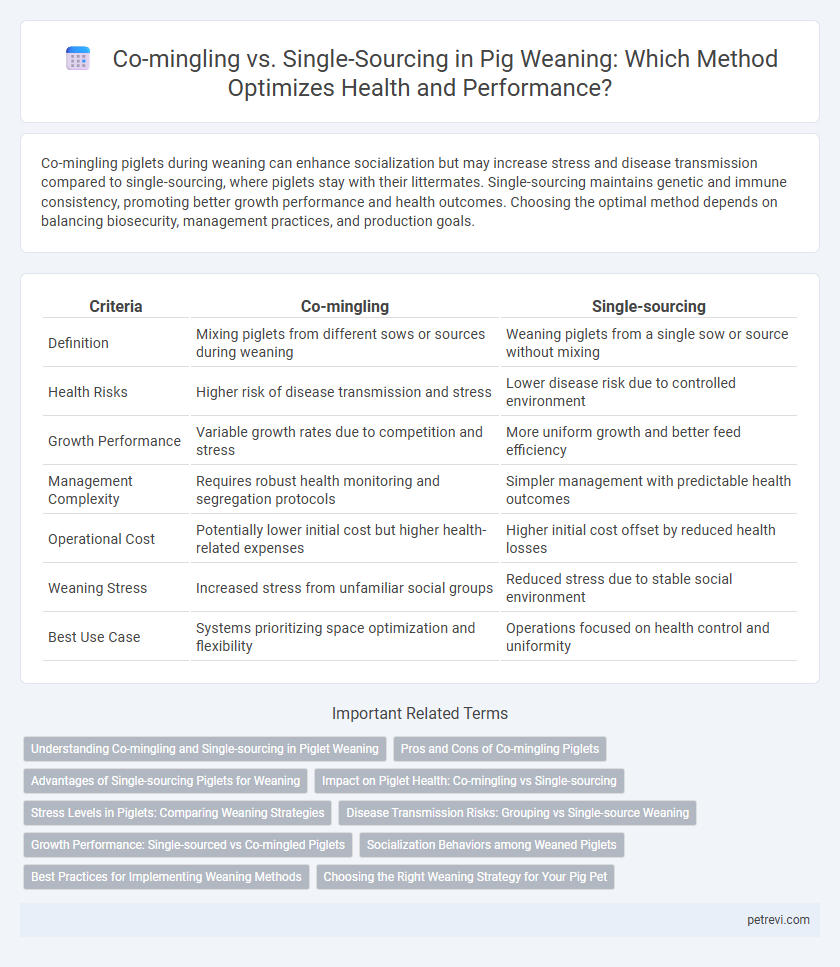Co-mingling piglets during weaning can enhance socialization but may increase stress and disease transmission compared to single-sourcing, where piglets stay with their littermates. Single-sourcing maintains genetic and immune consistency, promoting better growth performance and health outcomes. Choosing the optimal method depends on balancing biosecurity, management practices, and production goals.
Table of Comparison
| Criteria | Co-mingling | Single-sourcing |
|---|---|---|
| Definition | Mixing piglets from different sows or sources during weaning | Weaning piglets from a single sow or source without mixing |
| Health Risks | Higher risk of disease transmission and stress | Lower disease risk due to controlled environment |
| Growth Performance | Variable growth rates due to competition and stress | More uniform growth and better feed efficiency |
| Management Complexity | Requires robust health monitoring and segregation protocols | Simpler management with predictable health outcomes |
| Operational Cost | Potentially lower initial cost but higher health-related expenses | Higher initial cost offset by reduced health losses |
| Weaning Stress | Increased stress from unfamiliar social groups | Reduced stress due to stable social environment |
| Best Use Case | Systems prioritizing space optimization and flexibility | Operations focused on health control and uniformity |
Understanding Co-mingling and Single-sourcing in Piglet Weaning
Co-mingling in piglet weaning involves mixing piglets from multiple litters, which can promote socialization but may increase stress and disease transmission. Single-sourcing keeps piglets from the same litter together, reducing health risks and competition, leading to improved growth rates and welfare. Choosing the optimal strategy depends on farm biosecurity protocols, piglet health status, and management goals.
Pros and Cons of Co-mingling Piglets
Co-mingling piglets during weaning promotes socialization and can improve overall growth performance by encouraging natural behaviors and reducing stress through peer interactions. However, it increases the risk of disease transmission and potential aggressive behavior, which can lead to injury and uneven weight gain. Managing co-mingling environments requires strict biosecurity and monitoring to balance improved welfare with health risks.
Advantages of Single-sourcing Piglets for Weaning
Single-sourcing piglets for weaning minimizes disease transmission risks by maintaining consistent health status and reducing pathogen exposure compared to co-mingling. It enhances uniformity in piglet development, leading to improved growth performance and easier management of nutrition and health interventions. This practice supports better traceability and enables targeted vaccination programs, thereby optimizing overall herd health and productivity.
Impact on Piglet Health: Co-mingling vs Single-sourcing
Co-mingling piglets from multiple litters during weaning increases the risk of disease transmission and stress-related immune suppression, leading to higher incidences of respiratory and enteric infections. Single-sourcing piglets maintains litter integrity, reducing pathogen exposure and promoting stronger immune system development. Studies indicate single-sourcing significantly improves piglet health outcomes by minimizing cross-contamination and stress compared to co-mingling practices.
Stress Levels in Piglets: Comparing Weaning Strategies
Co-mingling piglets during weaning can increase stress levels due to social hierarchy disruptions and unfamiliar group dynamics, leading to elevated cortisol levels and aggressive behaviors. Single-sourcing maintains litter integrity, reducing social stress and promoting more stable post-weaning growth performance. Studies show that piglets weaned in single-source groups exhibit lower stress markers and better overall health compared to those from co-mingled groups.
Disease Transmission Risks: Grouping vs Single-source Weaning
Co-mingling piglets from multiple sources during weaning significantly increases the risk of disease transmission due to varied pathogen exposure and immune statuses. Single-source weaning limits pathogen introduction by maintaining a uniform health status and minimizing cross-contamination between groups. Implementing strict biosecurity measures and health screening enhances disease control regardless of the chosen weaning strategy.
Growth Performance: Single-sourced vs Co-mingled Piglets
Single-sourced piglets consistently exhibit higher average daily gain (ADG) and improved feed conversion ratios compared to co-mingled groups, likely due to reduced stress and lower pathogen exposure. Co-mingled piglets often face social hierarchy disruptions and increased disease transmission, which negatively impact growth performance during the critical weaning period. Studies reveal single-sourced weaning strategies enhance uniformity and overall growth metrics, supporting better production efficiency.
Socialization Behaviors among Weaned Piglets
Co-mingling piglets during weaning promotes enhanced socialization behaviors by facilitating earlier establishment of social hierarchies and reducing stress levels compared to single-sourcing practices. Studies indicate that co-mingled groups exhibit increased play behavior and exploratory activities, which contribute to improved social competence and resilience. In contrast, single-sourcing often results in limited social interaction opportunities, potentially leading to heightened aggression and slower adaptation post-weaning.
Best Practices for Implementing Weaning Methods
Co-mingling piglets at weaning can enhance socialization but raises risks of disease transmission, making biosecurity protocols crucial. Single-sourcing minimizes pathogen exposure by grouping piglets from the same litter, promoting uniform growth and reducing stress. Best practices include maintaining consistent environmental conditions, implementing strict sanitation measures, and monitoring piglet health closely to optimize outcomes regardless of the weaning method chosen.
Choosing the Right Weaning Strategy for Your Pig Pet
Choosing the right weaning strategy for your pig pet involves balancing health and growth outcomes between co-mingling and single-sourcing. Co-mingling pigs from multiple litters can enhance socialization but increases disease transmission risks, while single-sourcing minimizes pathogen exposure by keeping litter groups intact. Evaluating your pig's health status, biosecurity protocols, and environmental conditions ensures optimal weaning success and long-term well-being.
Co-mingling vs Single-sourcing for Pig weaning Infographic

 petrevi.com
petrevi.com